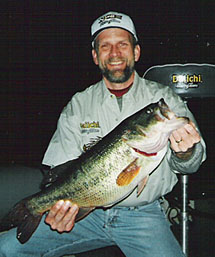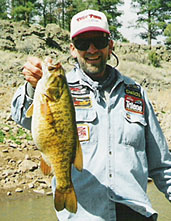"Wind Can Be Your Friend"
By Gregg Munck
Have you ever scheduled a special fishing trip way in advance? Maybe
for a vacation., or you hired a guide to fish unfamiliar water, which
you have been looking forward to for years. Possibly, it is the next
tournament on your favorite lake. Maybe you only have a couple of days
left to film some footage for an outdoors television show. Sure enough,
Mother Nature decides to pull some of her old tricks just as you are
hooking the boat trailer up to the truck.
Like I have always said, "You have to be smarter than the fish." The
fish make adjustments when the wind starts to blow, and you must also
make a few changes if you want to catch them. You can use wind to your
advantage, just like the fish will.
When the wind and waves are rocking and rolling, safety should be
your first consideration. Always check the local weather forecast.
It is mandatory that you know not only the capabilities, but also the limitations
of your boat and all the fishing equipment that comes with it.
Boat Control:
Having control over your boat speed is the first aspect that you need
to concentrate on. Once you have accomplished this, it will make the
presentation of your lure easier and much more effective. One common
method you can use to control the speed of your boat is drift socks.
Drift socks are manufactured in at least three different sizes and
many come with a drawstring so you're able to make adjustments in the
size of the sock to match the wind speed on a given day.
Trolling Motor:
Using a bow mount trolling motor is a familiar technique. Just position
the bow of your boat into the wind and adjust the speed setting on
the trolling motor. The trolling motor speed must match the wind speed
for that particular day and the lure presentation you have selected.
Back Trolling:
This is a very popular approach among walleye anglers. This can be
achieved by using a transom trolling motor or a smaller kicker motor
while in reverse, and adjust the motor speed to the wind speed on a
given day.
Anchoring:
Anchoring the boat from the bow and stem is another option especially
when you have located a good concentration of fish on your electronics.
On many lakes, you can find refuge from the majority of the wind. Try
sheltered bays, the slack side of rocky areas and points, and also
channel or dock areas.
Wind Direction:
The most stable weather patterns generally occur when you experience
wind flow from the south, west, and southwest, which can often influence
a more positive bite. Winds out of the north, east, and northeast usually
signifies certain changes in the weather pattern and often cause fish
to be more neutral or negative in their feeding responses.
Wind & Adverse Weather Conditions:
When I am faced with nasty conditions like wind, rain, sleet, and
the cold, the best approach is to SLOW DOWN. Adverse weather has a
way of messing with your head. Your natural reaction is to fish faster.
Fight that urge, and do the opposite.
On windy days, with most lure presentations, it is beneficial to
lower your rod tip just above the waters' surface so the wind can't
catch
the line. I am also a line watcher. I realize with only a couple
of inches of line exposed, it makes the line difficult to see,
so I overcome
this problem by putting my finger on the line to feel a pick-up.
Positive Effects of the Wind:
If you stop and think about it, the wind has many benefits. One example
is that the wind can increase or decrease the lakes' water temperatures
quite rapidly. For instance, in the spring, a southern flow can warm
the water by a few degrees. This subtle rise in the temperature is
all it takes to draw fish from their winter haunts where they begin
to search for a meal.
 From my experience, the larger, veteran fish are usually the first
ones to go on the prowl. If this occurrence doesn't excite you, then
I don't know what will! Wind often stirs up the shallows on a body
of water and quickly changes the clarity. You want to fish along
the edge where the discolored water meets the clear water. Fish
will hold
in the murky zone and use it as an ambush point waiting to dart out
and surprise unsuspecting prey that happen to be cruising by in the
clear water.
From my experience, the larger, veteran fish are usually the first
ones to go on the prowl. If this occurrence doesn't excite you, then
I don't know what will! Wind often stirs up the shallows on a body
of water and quickly changes the clarity. You want to fish along
the edge where the discolored water meets the clear water. Fish
will hold
in the murky zone and use it as an ambush point waiting to dart out
and surprise unsuspecting prey that happen to be cruising by in the
clear water.
Wind has a way of changing the water flow and creating current. While
this is happening, fish are repositioning themselves in the slack
water and near any current breaks. Fish will reserve as much of
their energy
as possible. They will hold behind rocks, wood, on the backside
of humps, on the slack side of bridge pilings, and any man-made
or natural
cover that tends to break the flow of water. Then they wait patiently
for a meal to drift by.
Certainly the wind helps oxygenate the water you're fishing. This
is a key aspect especially if you are fishing in the summer months
when the oxygen levels can be an issue.
Sunlight penetrations are no
longer a major concern on windy days. Wave action has a tendency
to reflect the rays of the sun so the fish
feel more secure than they would on calmer days.
Wind Tested Lures:
 My lure selection for chasing smallmouth bass starts out with half
ounce spinnerbaits and buzzbaits. I often tie on a spinnerbait with
a chartreuse skirt, complemented with chartreuse tandem willow blades.
The buzzbait skirts I choose are either chartreuse or chartreuse and
white. I also like to use buzzbaits with clackers for the days when
you need more commotion to draw a strike.
My lure selection for chasing smallmouth bass starts out with half
ounce spinnerbaits and buzzbaits. I often tie on a spinnerbait with
a chartreuse skirt, complemented with chartreuse tandem willow blades.
The buzzbait skirts I choose are either chartreuse or chartreuse and
white. I also like to use buzzbaits with clackers for the days when
you need more commotion to draw a strike.
For prop baits, I like Smithwicks, four and a half inch devil horse,
and Heddons four and a half inch wounded spook. Both of these models
have front and rear props, which can be adjusted to suit the mood
of the smallies on that particular day. For largemouth's, I use
the same
buzzbait selection as mentioned for the smallmouth bass. When throwing
spinnerbaits for largemouth, I use various size spinnerbaits depending
on the depth I am targeting.
I like a size 3-nickel Colorado blade on the front and a size 5 or
6 gold willow for the rear blade. When fishing with buzzbaits and
spinnerbaits, I attach a 2/0 Daiichi bleeding bait trailer hook,
unless my spinnerbait
is in heavy cover.
No matter where you fish, wind will always be there. I look forward
to those gusty days because I have experienced some of my truly
memorable catches using the wind as my friend.
For more information about Gregg Munck, just visit his website. http://www.munckstrophyfishing.com
Gregg Munck Bio

